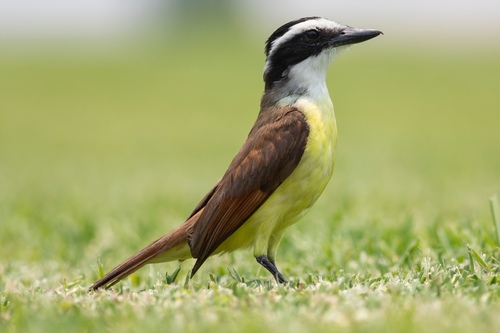
Great Kiskadee
The Great Kiskadee ( *Pitangus sulphuratus*) is a vibrant and boisterous flycatcher, easily recognized by its bright yellow underparts, black-and-white striped head, and rufous wings. This adaptable bird is a common sight across a wide range of habitats, from urban parks to dense forests, throughout its extensive range in the Americas. It plays a significant ecological role as both a predator of insects and small vertebrates, and a seed disperser for various plants. Its loud, onomatopoeic call, often transcribed as "kis-ka-dee," is a familiar sound in many regions, and the bird holds a place in local folklore in some cultures.
22-28 cm
Length
37-41 cm
Wingspan
Least Concern
Conservation Status
Distribution
The Great Kiskadee's range extends from southern Texas and Arizona in the United States, south through Mexico, Central America, and most of South America to central Argentina and Uruguay. It is also found on the islands of Trinidad and Tobago, and Bermuda. It is generally non-migratory, although some populations may make local movements in response to food availability.
Lifespan
The lifespan of wild Great Kiskadees is not well-documented, but likely averages 5-10 years, with some individuals potentially living longer.
Great Kiskadee's Habitat
Habitat Types
Open woodlands, Forest edges, Savannas, Agricultural areas, Urban parks, Wetlands, Riverbanks
Climate Zones
Tropical, Subtropical, Temperate
Adaptations
The Great Kiskadee shows remarkable adaptability to diverse environments. Its broad diet and opportunistic foraging behavior allow it to thrive in both natural and human-modified landscapes. Its tolerance of a wide range of temperatures and humidity levels contributes to its extensive distribution.
Variations
There are approximately ten recognized subspecies of the Great Kiskadee, differing slightly in size, plumage coloration, and vocalizations. These variations often reflect adaptations to local environmental conditions.
Appearance
Breeding Plumage
Plumage is generally consistent year-round.
Seasonal Feather Changes
No significant seasonal variation.
Sex Based Plumage Differences
Males and females have very similar plumage.
Notable Features
Bright yellow underparts, Black-and-white striped head with a concealed yellow crown patch, Rufous (reddish-brown) wings and tail, Stout, black bill
Diet and Feeding
Primary Foods
Insects, Small fish, Frogs, Lizards, Mice, Fruits, Berries, Seeds
Foraging Behavior
The Great Kiskadee is an opportunistic forager, employing a variety of techniques. It often perches on exposed branches, scanning for prey, then sallies out to capture insects in mid-air or glean them from foliage. It also hawks for insects, hovers to pluck fruits, and will even wade into shallow water to catch small fish and tadpoles.
Specializations
Its relatively large and robust bill allows it to handle a wider range of prey items than many smaller flycatchers. Its ability to switch between insectivory, frugivory, and even carnivory gives it a significant advantage in fluctuating environments.
Seasonal Diet Variations
Diet may vary seasonally depending on prey availability. For example, fruit and berries may become more important during certain times of the year when insects are less abundant.
Behavior
Social Structure
Great Kiskadees are typically found in pairs or small family groups, especially during the breeding season. They are not known to form large flocks.
Communication
Loud, distinctive "kis-ka-dee" call, Rapid chattering calls, Clicking sounds, Visual displays (e.g., raising the crown patch)
Migration
Generally non-migratory, although some populations may make short-distance movements in response to food availability or weather conditions.
Territorial or Group Behaviors
Highly territorial, especially during the breeding season. Pairs aggressively defend their nesting and foraging areas from other Kiskadees and potential predators. They are known to mob larger birds, including raptors.
Conservation
Threats
Habitat loss (although adaptable, extensive deforestation can impact populations), Pesticide use (indirectly through consumption of contaminated insects)
Protection Programs
Not currently subject to specific large-scale conservation programs due to its widespread distribution and adaptability.
Local National Laws
Protected under the Migratory Bird Treaty Act in the United States.
Population Trend
Stable
Population Estimates
While precise global population estimates are difficult, the Great Kiskadee is considered a common and widespread species.
Interesting Facts
They are known for their bold and aggressive behavior.
They will fearlessly attack much larger birds, including hawks and vultures, to defend their territory.
The scientific name, *Pitangus sulphuratus*, refers to its bright yellow belly.
'Sulphuratus' means 'sulfur-colored' in Latin.
They sometimes incorporate unusual materials into their nests.
This can include things like plastic scraps, string, and even snakeskin.
They are known to fish.
By hovering over the water and diving to snap the fish.
Faqs about Great Kiskadee
What is the Great Kiskadee's call like?
The call is a loud, ringing "kis-ka-dee," from which the bird gets its common name.
Are Great Kiskadees aggressive?
Yes, they are known for their territorial and aggressive behavior, especially during the breeding season.
Do Great Kiskadees migrate?
Most populations are non-migratory, but some may make short-distance movements.
What do they eat?
Insects, small vertebrates, fruits and seeds. They are very opportunistic feeders.
Copyright @ Nature Style Limited. All Rights Reserved.
 English
English